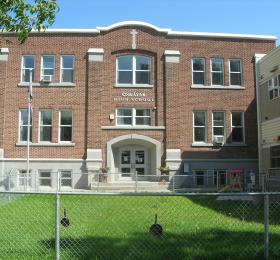Joe Duquette/Oskayak High School
- Regular
Description of the Historic Place
Joe Duquette / Oskayak High School is a large two storey brick building (with two steel frame additions) located in the neighbourhood of Nutana at 919 Broadway Avenue. Constructed in 1926, the school is an important educational institution for First Nations students.
Heritage Value
Joe Duquette / Oskayak High School originally opened as St. Joseph's Elementary Catholic School on December 17, 1928. Just over fifty years later, the school closed due to declining enrollment in 1980. The building was repurposed as the Joe Duquette High School, which was later named Oskayak High School. Joe Duquette High School was a special division of the Catholic School System which sought to preserve the cultural heritage of the First Nations community. With increasing numbers of Aboriginal youth enrolled in urban schools, it became very apparent from high dropout rates and from rising statistics in age-grade discrepancies of Aboriginal youth that present educational structures were not aware of or able to address the language and cultural differences inherent in Aboriginal students. Joe Duquette / Oskayak High School is one of a series of urban Aboriginal schools in Canada
The school was named in honour of Joe Duquette, an elder from the Mistawasis First Nation who had worked with students and teachers at the school in the early 1980s. Oskayak High School was eventually selected as the new name for Joe Duquette High School. Oskayak means "young people" in Cree. It was felt this name captured the community belief that the school is for all young people. Since the opening of the Joe Duquette / Oskayak High School, student enrollments have continued to rise. The student-centered programs have attracted many urban Aboriginal youth to return to school to complete their high school education.
Source: City of Saskatoon Built Heritage Database
Character Defining Elements
Key elements which contribute to the heritage value of this historic resource include:
- Those features that relate to its historical and cultural value including its imposing and elaborate appearance, its location along Broadway Avenue, and its continued use as a facility geared towards Aboriginal youth; and
- Its architectural features, including the original building’s brick façade, parapet roofline, arched doorways and window sills.

